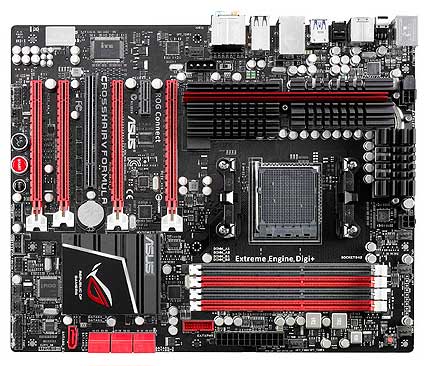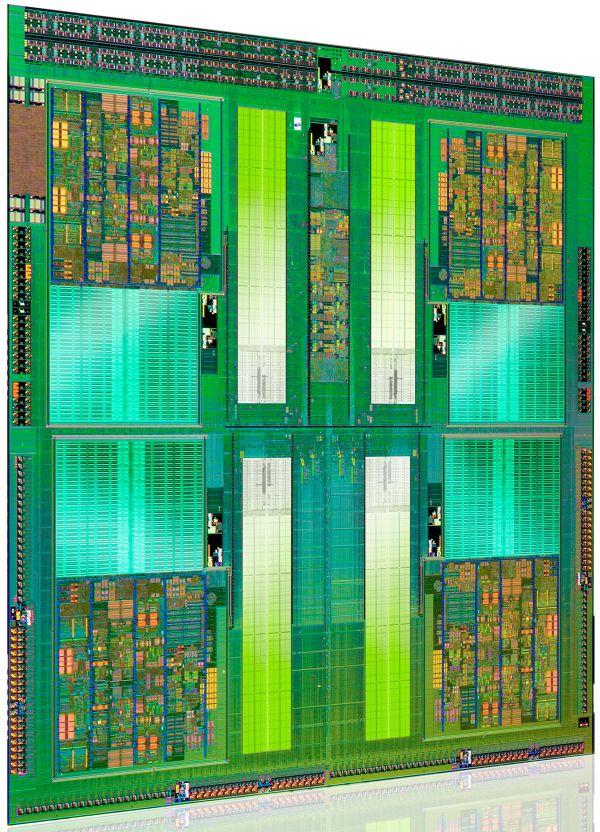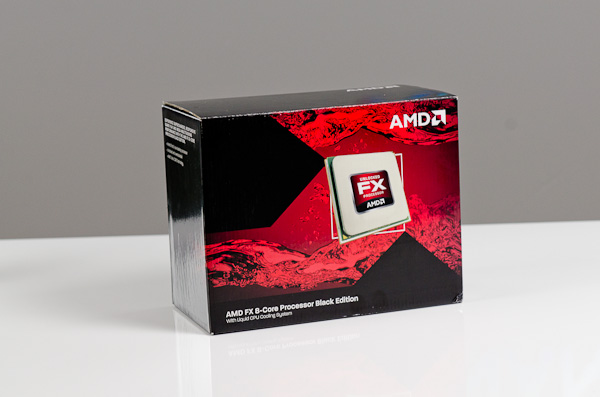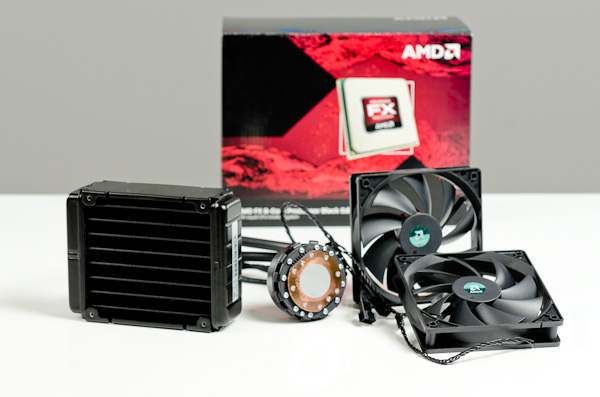The Bulldozer Review: AMD FX-8150 Tested
by Anand Lal Shimpi on October 12, 2011 1:27 AM ESTAMD has been trailing Intel in the x86 performance space for years now. Ever since the introduction of the first Core 2 processors in 2006, AMD hasn't been able to recover and return to the heyday of the Athlon 64 and Athlon 64 X2. Instead the company has remained relevant by driving costs down and competing largely in the sub-$200 microprocessor space. AMD's ability to hold on was largely due to its more-cores-for-less strategy. Thanks to aggressive pricing on its triple and hexa-core parts, for users who needed tons of cores, AMD has been delivering a lot of value over the past couple of years.
Recently however Intel has been able to drive its per-core performance up with Sandy Bridge, where it's becoming increasingly difficult to recommend AMD alternatives with higher core counts. The heavily threaded desktop niche is tough to sell to, particularly when you force users to take a significant hit on single threaded performance in order to achieve value there. For a while now AMD has needed a brand new architecture, something that could lead to dominance in heavily threaded workloads while addressing its deficiencies in lightly threaded consumer workloads. After much waiting, we get that new architecture today. Bulldozer is here.
It's branded the AMD FX processor and it's only available in a single die configuration. Measuring 315mm2 and weighing in at around 2 billion transistors (that's nearly GPU-sized fellas), Bulldozer isn't that much smaller than existing 45nm 6-core Phenom II designs despite being built on Global Foundries' 32nm SOI process. Both die area and transistor count are up significantly over Sandy Bridge, which on Intel's 32nm HKMG process is only 995M transistors with a die size of 216mm2. This is one big chip.
| CPU Specification Comparison | ||||||||
| CPU | Manufacturing Process | Cores | Transistor Count | Die Size | ||||
| AMD Bulldozer 8C | 32nm | 8 | 1.2B* | 315mm2 | ||||
| AMD Thuban 6C | 45nm | 6 | 904M | 346mm2 | ||||
| AMD Deneb 4C | 45nm | 4 | 758M | 258mm2 | ||||
| Intel Gulftown 6C | 32nm | 6 | 1.17B | 240mm2 | ||||
| Intel Nehalem/Bloomfield 4C | 45nm | 4 | 731M | 263mm2 | ||||
| Intel Sandy Bridge 4C | 32nm | 4 | 995M | 216mm2 | ||||
| Intel Lynnfield 4C | 45nm | 4 | 774M | 296mm2 | ||||
| Intel Clarkdale 2C | 32nm | 2 | 384M | 81mm2 | ||||
| Intel Sandy Bridge 2C (GT1) | 32nm | 2 | 504M | 131mm2 | ||||
| Intel Sandy Bridge 2C (GT2) | 32nm | 2 | 624M | 149mm2 | ||||
Update: AMD originally told us Bulldozer was a 2B transistor chip. It has since told us that the 8C Bulldozer is actually 1.2B transistors. The die size is still accurate at 315mm2.
Architecturally Bulldozer is a significant departure from anything we've ever seen before. We'll go into greater detail later on in this piece, but the building block in AMD's latest architecture is the Bulldozer module. Each module features two integer cores and a shared floating point core. FP hardware is larger and used less frequently in desktop (and server workloads), so AMD decided to share it between every two cores rather than offer a 1:1 ratio between int/fp cores on Bulldozer. AMD advertises Bulldozer based FX parts based on the number of integer cores. Thus a two module Bulldozer CPU, has four integer cores (and 2 FP cores) and is thus sold as a quad-core CPU. A four module Bulldozer part with eight integer cores is called an eight-core CPU. There are obvious implications from a performance standpoint, but we'll get to those shortly.
The FX Lineup
There are a total of 7 AMD FX CPUs that AMD is announcing today, although only four are slated for near-term availability.
| CPU Specification Comparison | |||||||||
| Processor | Cores | Clock Speed | Max Turbo | NB Clock | L2 Cache | TDP | Price | ||
| AMD FX-8150 | 8 | 3.6GHz | 4.2GHz | 2.2GHz | 8MB | 125W | $245 | ||
| AMD FX-8120 | 8 | 3.1GHz | 4.0GHz | 2.2GHz | 8MB | 95W/125W | $205 | ||
| AMD FX-8100* | 8 | 2.8GHz | 3.7GHz | 2GHz | 8MB | 95W | N/A | ||
| AMD FX-6100 | 6 | 3.3GHz | 3.9GHz | 2GHz | 6MB | 95W | $165 | ||
| AMD FX-4170* | 4 | 4.2GHz | 4.3GHz | 2.2GHz | 4MB | 125W | N/A | ||
| AMD FX-B4150* | 4 | 3.8GHz | 4GHz | 2.2GHz | 4MB | 95W | N/A | ||
| AMD FX-4100 | 4 | 3.6GHz | 3.8GHz | 2GHz | 4MB | 95W | $115 | ||
| AMD Phenom II X6 1100T | 6 | 3.2GHz | 3.6GHz | 2GHz | 3MB | 125W | $190 | ||
| AMD Phenom II X4 980 | 4 | 3.7GHz | N/A | 2GHz | 2MB | 125W | $170 | ||
The FX-8150, 8120, 6100 and 4100 are what's launching today. The first digit in AMD's FX model numbers indicates the number of cores with the 8150 and 8120 boasting eight, while the 6100 only has six active integer cores (three Bulldozer modules). The FX-4100 features four integer cores. L2 cache scales with core count (2MB per module), while the L3 cache size remains fixed at 8MB regardless of SKU.
North Bridge and L3 cache frequency alternate between 2.0GHz and 2.2GHz depending on the part. TDPs range between 95W and 125W as well, with the FX-8120 being offered in both 125W and 95W versions.
There's only a single Bulldozer die. The 6 and 4 core versions simply feature cores disabled on the die. AMD insists this time around, core unlocking won't be possible on these harvested parts.
The huge gap in clock speed between the 8120 and 8150 are troubling. Typically we see linear frequency graduations but the fact that there's a 16% difference between these two SKUs seems to point to process problems limiting yield at higher frequencies—at least for the 8-core version.
Outside of the quad-core and hex-core Bulldozer pats, the only other FX processor able to exceed the 3.3GHz clock speed of the Phenom II X6 1100T is the 8150. And if you include quad-core Phenom II parts in the mix, only two Bulldozer parts ship at a higher stock frequency than the Phenom II X4 980. Granted Turbo Core will help push frequencies even higher, but these low base frequencies are troubling. For an architecture that was designed to scale to clock speeds 30% higher than its predecessor, Bulldozer doesn't seem to be coming anywhere close.
The entire FX lineup ships unlocked, which allows for some easy overclocking as you'll see soon enough.
Motherboard Compatibility
AMD is certifying its FX processors for use on Socket-AM3+ motherboards. Owners of standard AM3 motherboards may be out of luck, although motherboard manufacturers can choose to certify their boards for use with Bulldozer if they wish to do so. From AMD's perspective however, only AM3+ motherboards with BIOS/UEFI support for Bulldozer are officially supported.
All existing AM2/AM2+/AM3/AM3+ heatsinks should work with the FX processor; they simply need to be rated for the TDP of the processor you're looking to cool.

For this review, AMD supplied us with ASUS' Crosshair V Formula AM3+ motherboard based on AMD's 990FX chipset.
AMD does offer six 6Gbps SATA ports on its 990FX chipset, a significant upgrade from the two 6Gbps ports on Intel's 6-series chipsets. Unbuffered ECC memory is also supported for those who desire the added security, once again a feature not supported on Intel's consumer grade 6-series chipsets.
Despite AMD's trend towards releasing APUs with integrated GPUs (thus requiring a new socket), AMD insists that the AM3+ platform will live to see one more processor generation before it's retired.
AMD's Liquid CPU Cooling System
Alongside its new FX processors AMD is introducing its first branded liquid cooling system manufactured by Asetek.
AMD's cooling system is similar to other offerings from companies like Antec and Corsair. The system is self contained, you never have to worry about adding any more liquid to it.
Attach the cooling module to your CPU socket via a simple bracket, and affix the radiator to your case and you're good to go. The radiator is cooled via two 120mm fans, also included in the box.
AMD doesn't have an exact idea on pricing or availability of its liquid cooling solution, but I'm told to expect it to be around $100 once available. My sample actually arrived less than 12 hours ago, so expect a follow up with performance analysis later this week.
The Roadmap
For the first time in far too long, AMD is actually being very forthcoming about its future plans. At a recent tech day about Bulldozer, AMD laid out its CPU core roadmap through 2014. The code names are below:
Piledriver you already know about, it's at the heart of Trinity, which is the 2—4 core APU due out in early 2012. Piledriver will increase CPU core performance by around 10—15% over Bulldozer, although it will initially appear in a lower performance segment. Remember that final generation of AM3+ CPU I mentioned earlier? I fully expect that to be a GPU-less Piledriver CPU due out sometime in 2012.
Steamroller will follow in 2013, again improving performance (at the core level) by around 10—15%. Excavator will do the same in 2014. AMD believes that these performance increases will be sufficient to keep up with Intel over time, however I'll let you be the judge of that once we get to the Bulldozer performance numbers.
The other thing to note about AMD's roadmap is it effectively puts the x86 business on an annual cadence, in line with what we've seen from the AMD GPU folks. Although AMD isn't talking about what process nodes to expect all of these cores at, it looks like AMD will finally have an answer to Intel's tick-tock release schedule moving forward.























430 Comments
View All Comments
stephenbrooks - Thursday, October 13, 2011 - link
Not trying to argue with you about the accuracy issue - if "FMA" is defined in a certain way, that's how it's defined and an instruction that rounds differently is a different instruction.However, imagine AMD could implement a "Legacy FMA" (LFMA) instruction in their FPU - which would round as if the MUL came first. You could then fuse MUL, ADD pairs into LFMA instructions without producing bugs. Not sure whether the two types of FMA could be done on the same hardware (they are basically different rounding modes) without a large overhead though.
I don't really understand why there's a big demand for not rounding after the MUL because normally these instructions show up in code like
for (n=1000;n>0;n--) total+=a[n]*b[n];
...and the potential rounding inaccuracy comes in the add stage: there are often lots of adds in sequence, but not normally lots of MULs, and adds suffer more often from the problem of accumulating many small values. Anyway, I know in my code there are lots of instances of doing the "multiply add" operation, and it would be nice to have some sort of CPU acceleration for this.
TheDude69 - Wednesday, October 12, 2011 - link
The Party is over! AMD is no more! They have successfully designed themselves out of the desktop CPU business. I applied for their CEO position and they went with a Moron! You can all kiss low, desktop CPU prices goodbye! Congratulations INTEL you now have a CPU Monopoly!! We can only hope that Nvidia will come through with a Super fast Tegra that will outperform Intel in the netbook arena.I don't think AMD can pull a rabbit out of it's hat now. Guess I'll cave in and buy an i7.
I feel like I'm going to puke........................
policeman0077 - Wednesday, October 12, 2011 - link
I am a newbie, have quite a lot of questions after reading the review of bulldozer.1. what is heavily thread tasks?does matlab count as heavily thread task?I heard matlab use a lot of FP resource? If so,how can bulldozer beat i5 with only 4 lower efficiency FPs ? Does browsing a lot of website simultaneously count?
2. if single core cpu A and B have same frequency but different efficiency and work on same task without full load. They will accomplish the task in same time?
3. so if single core/thread performance is very important, the situation I aforementioned(if is true) totally doesn't show the benefit of a high efficiency core? (didn't consider power consumption.)
4. Does many application will let a core fully loaded and they won't split the task to another core? What kind of application suit this kind of situation? Any example?
5. in the case of 2, if another application request cpu's resource, will the core with high efficiency get quicker response?
6. in the case of 2, consider multi core cpus A and B. if one core of these two cpus are nearly full loaded, at the same time, another application request the source of cpu. And the operate system decide to let this application work on another idle core. Will higher efficiency core response fast?
TheDude69 - Wednesday, October 12, 2011 - link
Don't bother....I have been following this saga since AMD's first CPU and, until today, was an AMD Fan boy. Buy an i7 now before Intel triples the price for this CPU!GustoGuy - Wednesday, October 12, 2011 - link
I am really surprised that AMD didn't at least match the i7 in a majority of the bench marks, and what is even more disturbing is that it sometimes performs worse than a Phenom II X4 on some bench marks. AMD could have tweak this processor with all the time it took and had a stationary target with the i7 so I am perplexed at why they were not able to get it to benchmark at least as well as an entry level i7. Hopefully it will be like the first generation of the Phenom x4 where AMD was able to add an l3 cache and tweak the overclocking abilities so they could rease a product that was at least competitve with the Core Duo processors. I like AMD however they have to be copetitive with Intel and can not afford to give up in some cases a 50% decificiency when compared to the i7.Belard - Wednesday, October 12, 2011 - link
There isn't much AMD can do with this. They are "planning" on having a TICK TICK TICK 10~15% performance increase with yields, higher clocks and tweaks, which what they and intel normally do.True, we CANNOT expect AMD to compete directly with Intel. They simply don't have the resources. Not the money, not the talent, not the manufacturing abilities. Perhaps, if they were not HELD DOWN by intel during the AMD32~64 days, they'd have made the much-needed profits to afford a much bigger R&D department. There was a point at the end of the AMD64/X2 dominance in which AMD couldn't make enough CPUs.
If the 8150 was marketed as it is... a quad core CPU and was across the board, no more than 15% slower than the 2600 at a price of $220 (The 2600 sells at $300) then it would be considered a GOOD buy. But its worse than that in performance and price.
It takes years to develop a new CHIP. It would take 1-2 years to fix the problems with bulldog, if they could be fixed. But look at it this way, how did intel fix their P4/Netburst problem? Oh yeah, they developed a whole new design!!
BD is a s flawed as the P4. Its very difficult to FIX a HUGE CPU.. and SB is about half as complex and half the size of BD! So what... AMD is going to add even more junk to the design?
Hence, it costs AMD about twice as much to make such a CPU compared to intel. So do the math. Intel makes more profit per CPU. For AMD to compete, they would need to reduce their price by 25~30% - which means almost NO profit.
AMD is screwed. They'll really need to work with Llano a lot more... and look at burying Bulldozer with something else.
If Piledriver does somehow kick butt (there are no indications that it will) - too bad, a large chunk of AMD users would have already moved on to intel. And when Piledriver does finally hit the market, intel will have already released an ever faster CPU.
Did I say AMD is screwed?
Belard - Wednesday, October 12, 2011 - link
Seriously?While I won't call myself an AMD fanboy - as I own both intel and AMD systems... I've been drooling for a Sandy Bridge like AMD part. I buy and sell AMD systems for years for desktop users. In general, I prefer AMD chipsets over intels, I like your GPUs, etc... With the release of BD (Bulldozer) FX chips... the WAIT IS OVER!!!
My next system will be an Intel... my next customer builds will be intels with 2300~2600k CPUs.
I *CANNOT* sell my customers a sub-standard part, which is what BD is. Why the hell would I have them spend $250 for a CPU that can't constantly compete with a $150 or 2 year old CPUs?
I think we know why Rick Bergman left AMD, I don't see him signing off on such a crappy CPU. Seriously, why bother? Llano OLDER Fusion design is more attractive than this insulting FX garbage.
What AMD has done with the release of these BD/FX chips is created more sales for intel, nothing more. Only a fool would buy an FX 8150... just like the fools who spent $1000 on the Intel EE CPUs (okay, not quite that dumb since these AMDs are 1/4 such prices) These 8core CPUs are actually 4 core, 6 = 3 and 4 is a dual core. An enhanced version of Hyper-threading by Intel 10 years ago.
There is a SEVERE problem when your "8 core" CPU can't surpass intel's $150 dual core CPUs. Why AMD, why did you take a page out of intel and Nvidia and do the SAME stupid thing? This *IS* your Netburst and FERMI all wrapped in one. A BIG, HOT, EXPENSIVE and SLooooow product that doesn't impress anyone, other than the stupidity of the design. You think WE should wait 2-3 years for you to ramp up speed to 5-6Ghz to say you're competitive with TODAYS intel CPUs? I don't think so.
After an hour or so of reading this review, here is what happened. 5 sales for desktop builds have just gone to Intel i-whatever-it-is 2500 & 2600s. You make me and others LOOK LIKE FOOLS waiting for Bulldozer or Bulldog to come out and kick some intel butt. You didn't. No, we were NOT expecting you to surpass Sandbridge (SB)... but if your "$250 8150 Best CPU" was at least up against the 2500~2600 in performance, it would be acceptable. But on Newegg - this $280 CPU is slower in most benchmarks to the i5-2400 which is $180. The 8150's power usage and heat is through the roof from the faster i5-2400 which is $100 cheaper and faster in games and most productivity.
No gamer in their right mind would spend nearly $300 for a CPU that is about 25~40% slower than the similar or cheaper priced Intels. Big deal if they are unlocked... so are the K chips, which would only pull ahead further.
(We could use a review showing a 5Ghz 8150 vs a 5Ghz 2600K - but I would expect the AMD deficit to remain)
The heatsinks on SB CPUs are tiny compared to AMD... that means less noise, less heat.
If a client needs a custom budget computer, I'd go with a $100~130 AMD CPU... that is it. If AMD wants to compete with the CURRENT Sandy Bridge, the 8150 will need to be a sub $200 part (Hey, isn't intel about to drop their prices??) Their BS "4 core" will need to be $100... but we'll need to see how it performs in the real world... to see if its worth that much money.
This article has over 250 posts in less than 24hrs.... and its the voices of very unhappy AMD users.
I still can't believe AMD went the P4 route. They spent years trying to CHEAT performance and this is the result? Luckily there is lots of demands for cheap CPUs and ATI GPUs which should keep AMD alive.
descendency - Thursday, October 13, 2011 - link
The thing that bothers me most is the Dirt 3 performance.According to an AMD rep at the AMD launch press-conference, games like Dirt 3 would be able to utilize the Bulldozer's "8 cores" to deliver awesome performance. The truth is that it does worse than the 1100T (the one I already own).
wolfman3k5 - Thursday, October 13, 2011 - link
It's finally here! I have been waiting for one of these. It's another Hitler Video, this time it's about Bulldozer. Funny as hell...The video can be found here: http://www.youtube.com/watch?v=SArxcnpXStE
Artas1984 - Thursday, October 13, 2011 - link
Hey thanks for notice! I was expecting this already!